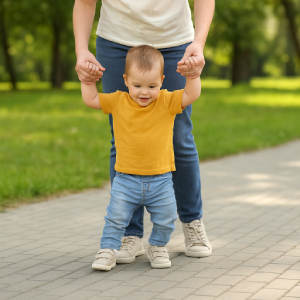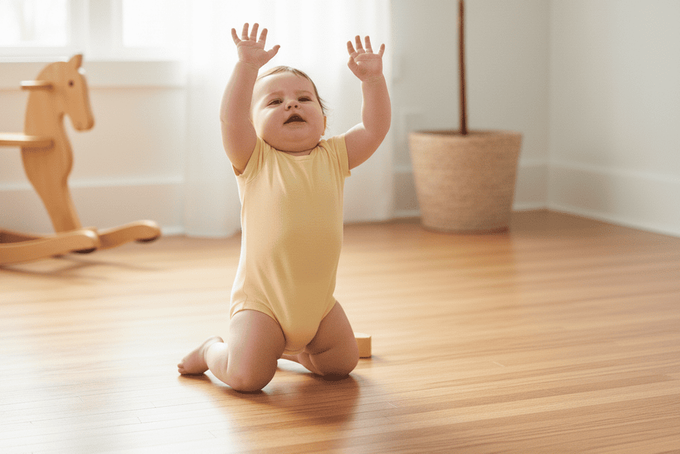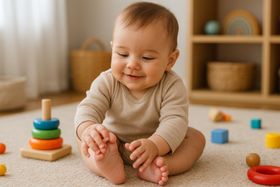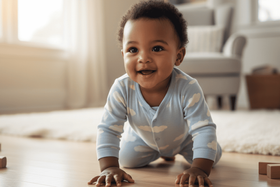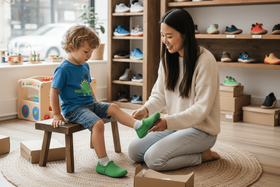When Do Babies Typically Pull to Stand for the First Time?
Most babies pull to stand between 8-12 months old, though every child develops at their own pace. You'll notice signs like your baby holding onto furniture, getting stronger during diaper changes, and showing interest in being upright—all normal steps toward independent standing and walking.
Published October 8, 2025

You're watching your 9-month-old scoot across the living room floor when suddenly, she grabs the coffee table and pulls herself up on wobbly legs. You're probably wondering if she's ready for this.
Pulling to stand is one of those exciting toddler gross motor milestones that show that your baby is getting closer to walking. But the timeline is more than you might think, and that's completely normal.
Here's what you need to know about when babies typically pull to stand, what signs show your baby is ready, and how you can support this important developmental step.
The Typical Timeline for When Babies Pull to Stand
If you're wondering when your baby will pull to stand, here's some reassuring news: most babies achieve this milestone between 8 and 12 months old, and there's quite a bit of normal variation in this range.
The CDC recognizes 12 months as a key marker, meaning about 75% of babies can pull to stand by their first birthday, but that also means 25% take a little longer, and that's okay too [1].
In clinical practice, many babies achieve this milestone around 9 or 10 months old. Some start a bit earlier, others a bit later—and both are perfectly normal. Your baby is developing on their own unique timeline.
You might notice your baby might pull up to their knees first, then figure out how to get their feet underneath them. Other babies are agile enough to stand directly on their feet as they pull up. Both are common and show your baby is problem-solving and building strength.
Pro tip: This milestone doesn't happen on its own. A baby pulling to stand usually develops alongside or shortly after crawling, though some babies skip crawling entirely and go straight from sitting to pulling themselves up. Keep in mind that every baby's path to mobility looks a little different.
What Affects When Babies Pulling Up to Stand
Several factors can influence when your baby will pull to stand, and here's something important to know: most have nothing to do with your parenting or your baby's future abilities. Let's look at what really matters.
Floor Play Time Affecting Babies Pulling Up to Stand
Babies need plenty of opportunities to move freely on the floor to build the core and leg strength required for pulling to stand.
If your baby spends most of their time being held, in a carrier, or in equipment like bouncers or walkers, they may reach this milestone a bit later. This can slow your child's development. After all, your little one wouldn't have had as much practice or opportunity to move around [2].
Temperament Affecting Babies Pulling Up to Stand
Some babies are natural risk-takers who eagerly attempt new physical challenges. Others are more cautious and take their time observing before trying something new. Neither approach is better; they're just different personality styles.
Birth Timing Affecting Babies Pulling Up to Stand
If your baby was born prematurely, their developmental milestones are assessed based on corrected age (subtracting how early they were born from their current age). A 9-month-old who was born 7 weeks early would have the developmental expectations of an 8-month-old [3].
Family Circumstances Affecting Babies Pulling Up to Stand
Babies who split time between different households may experience variations in caregiving approaches that can affect milestone timing. Socioeconomic factors, including living space and safe play areas, can also influence when babies reach motor milestones.
Variation in timing is normal and expected. Your baby will pull to stand when their body and brain are ready.
Signs Your Baby Is Ready to Pull to Stand
Your baby will show you they're getting ready to pull to stand through different telltale behaviors. Watch for these signs that show your baby is building the necessary strength and coordination:
1. Your Baby Holds Onto You During Diaper Changes
One of the earliest signs happens on the changing table. Your baby grabs onto your hands or arms and tries to pull themselves up off the changing surface. This shows they're developing the arm and core strength needed for pulling to stand.
2. Your Baby Gets Up on Their Knees in the Crib
You might find your baby holding onto the crib rails while up on their knees. This is practice for the full standing motion and shows your baby is figuring out how to use furniture for support.
3. Your Baby Crawls Toward Furniture and Investigates
If your baby is crawling, you'll notice them making their way to the couch, coffee table, or other sturdy objects. They'll place one hand on the furniture, then work on figuring out how to pull themselves up.
After some practice, they realize that two hands give more stability and successfully reach a standing position.
4. Your Baby Has Strong Trunk Control
By the time babies pull to stand, they've mastered sitting up independently and can move from lying down to sitting without help. This core strength is very important for standing.
What If Your Baby Isn't Pulling to Stand Yet
If your baby hasn't pulled to stand by 9 or 10 months, take a breath—this is usually no cause for concern. Many babies are simply still building their strength and confidence.
However, you'll want to consider whether your baby is getting enough floor play time. Babies who are frequently held, carried, or placed in equipment may simply need more opportunities to practice their motor skills.
Once given more floor time, many babies make rapid progress—sometimes achieving the milestone within just a few weeks.
When to Talk to Your Pediatrician About Babies Pulling Up to Stand
You should mention your baby's development to your healthcare provider if:
- Your baby hasn't pulled to stand by 12 months and isn't showing signs of trying.
- Your baby has other developmental delays in areas like fine motor skills or speech.
- Your baby seems to have weak muscle tone or unusual stiffness.
- Your baby was pulling to stand but has stopped or seems to have lost skills (loss of previously achieved milestones should always be discussed with your pediatrician).
If your pediatrician recommends evaluation, know that this is a proactive step, not a cause for panic. Many babies who are later to pull to stand catch up quickly with no intervention needed.
What Developmental Screening Involves for Babies Pulling Up to Stand
If your pediatrician recommends evaluation, the first step is often a referral to Early Intervention services. Children under age three qualify for these assessments, which involve a look at all developmental areas.
When motor delays are detected, you'll work with a physical therapist who can provide exercises and activities to help your baby build strength and coordination.
Many programs offer home visits, making it convenient for your family. Your baby will be reassessed every 6-12 months to determine if additional support is needed.
For babies with specific motor concerns or multiple developmental delays, your pediatrician may refer you to a pediatric neurologist or developmental pediatrician for further evaluation.
How to Safely Encourage Babies to Pull to Stand
You can support your baby's journey to standing without pushing them before they're ready. The key is creating opportunities for practice while keeping safety front and center.
1. Create a Safe Environment for Babies Pulling to Stand
Safety is important, but don't let the list below stress you out; you don't have to do everything at once. Start with the biggest risks (furniture anchoring and sharp corners) and work through the rest as your baby becomes more mobile.
- Secure all furniture that could tip over. Bookcases, dressers, TV stands, and other tall furniture must be anchored to the wall. Babies learning to pull to stand will grab onto anything within reach, and toppling furniture is a serious injury risk.
- Remove or relocate fragile items. Glass tables, ceramic planters, and other breakable objects should be moved to areas your baby cannot access. This protects both your belongings and your baby from sharp edges and broken pieces.
- Install safety gates and locks. Place gates at the top and bottom of stairs and in kitchen doorways. Add safety locks to cabinets, especially those containing cleaning products or other hazards. As your baby starts walking, consider installing out-of-reach locks on closets and exterior doors.
- Pad sharp corners. Coffee tables and other furniture with sharp edges should have corner guards to protect your baby during inevitable tumbles.
2. Provide Plenty of Floor Play Time for Babies Pulling to Stand
The single most important thing you can do is give your baby lots of time to move freely on the floor. This builds the core and leg muscle strength necessary for pulling to stand.
Try to avoid overusing equipment like walkers, which can actually delay motor development by providing artificial support. Your baby needs to develop their own strength and balance, which only happens through independent practice.
3. Offer Appropriate Support Objects for Babies Pulling to Stand
Place sturdy, stable objects at your baby's chest level that are easy to grab. Ottomans, coffee tables, and sturdy toy boxes work well. Avoid furniture with wheels or anything that could slide or tip.
You can also try placing your baby in a kneeling position while they hold onto a firm object. This helps them practice the motion of pulling up. Soft objects like couch cushions are more challenging and can provide additional strength-building practice once your baby has mastered standing with firmer support.
4. Make Pulling Up to Stand Playful and Engaging
Place your little one's favorite toys on elevated surfaces like the couch or coffee table to encourage your baby to pull up to reach them. Play games that encourage reaching to each side, which builds core strength and balance.
During floor play, you can position yourself or objects just out of reach to motivate your baby to move and eventually pull themselves up to investigate.
Pro tip: The key is making practice feel like play, not work. If your baby seems frustrated or tired, take a break—the best learning happens when they're having fun and feeling confident.
Supporting Your Baby's Journey to Standing
Pulling to stand is an exciting milestone that shows your baby is building strength, coordination, and confidence. Most babies reach this between 8 and 12 months, but your baby's individual timeline is normal for them. The best thing you can do is provide plenty of safe floor play time, childproof your home, and avoid comparing your baby to others.
If you have concerns about your baby's motor development, talk to your pediatrician rather than relying solely on advice from other parents. Trust yourself—you know your child best, and it's always okay to ask for professional reassurance.
As your baby progresses to cruising and walking, ensure they have proper footwear like First Walkers' orthopaedic range that supports healthy foot development. Learn more about choosing the right shoes for babies learning to stand and walk to give your little one the support they need for these exciting next steps.
References
Your baby at 12 months. (n.d.). cdc.gov. https://www.cdc.gov/ncbddd/actearly/pdf/checklists/checklists_1yr.pdf
Badihian, S., Adihian, N., & Yaghini, O. (n.d.). The Effect of Baby walker on Child Development: A Systematic review. https://pmc.ncbi.nlm.nih.gov/articles/PMC5703622/
Elmrayed, S., Dai, S., Lodha, A., Kumar, M., & Fenton, T. R. (2025). Preterm growth assessment: the latest findings on age correction. Journal of Perinatology. https://doi.org/10.1038/s41372-024-02202-z
Disclaimer: First Walkers' information is intended for educational and informational purposes related to toddler footwear and feet. We encourage you to consider individual circumstances and consult qualified orthopedists about specific conditions.
FAQs
What age do babies stand on their own without support?
Most babies stand independently (without holding onto furniture) between 9-12 months, though some don't achieve this until 14-15 months. Standing without support typically comes 1-2 months after learning to pull to stand with support.
Is it normal for my baby to pull to stand before they crawl?
Yes, some babies skip crawling entirely and go straight from sitting to pulling up to stand. As long as your baby is showing overall progression in motor skills, the specific order of milestones can vary.
Can I help my baby learn to stand by holding their hands and pulling them up?
Avoid pulling your baby up by the hands before they're ready. If your baby can't yet sit independently or shows no interest in pulling up, their muscles aren't ready for standing practice. Let your baby start standing attempts when their body is developmentally prepared.
Should babies wear shoes when learning to pull to stand?
Babies learning to pull to stand benefit from being barefoot indoors, which helps them develop balance and foot strength. Soft-soled shoes are appropriate for outdoor protection. Avoid stiff or hard-soled shoes until your baby is walking confidently.

